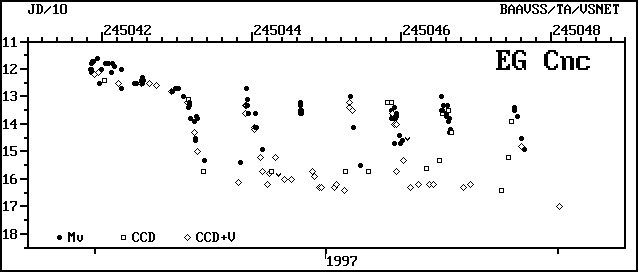
A major outburst of the long period dwarf novae EG Cancri occurred at the end of November 1996, and has revealed many surprises! Only one other outburst had been recorded and confirmed - November 1977 - although there was one unconfirmed sighting in October 1996. Originally described as a Nova Like variable, it had been suggested that EG Cnc might resemble a long period dwarf nova. The detection of superhumps by observers at Ouda in Japan and by CBA observers in the USA on December 3/4 confirmed that the outburst was a supermaximum, and that EG Cnc was probably a member of the WZ Sge type stars, owing to it's large amplitude and long recurrence period. The superhump period was measured at 0.0604d, with a maximum amplitude of 0.2 mag.
The outburst was detected by the German amateur Patrick Schmeer on November 30th, then reached magnitude 11.5 on December 1st. By December 15th it had faded to 15.7. Some five days later a not too unexpected second outburst was observed, reaching magnitude 12.7 and lasting just 3 days. This outburst also displayed superhumps. On December 28th a third outburst occurred, lasting 2d. This was then followed by a further four outbursts at intervals ranging from 3d to 8d, each lasting approximately 2 days and reaching similar magnitudes (see plot). As I write these words (Jan 28th), EG Cnc has just faded from outburst number seven. Amazing behaviour for a star which had been inactive (as far as we know) for 19 years!
Tidal instability is thought to be the cause of these enigmatic post outburst brightenings, although from many messages posted on to VSNET it is clear that this series of outbursts has caused much `head scratching' among the CV community!

The plot displays observations retrieved from VSNET, and those reported
directly to the Director. Observers are...
Visual;- Broens, Dillon, Hanson, Itoh, Kinnunen, Makiguchi, Pietz, Poyner,
Schmeer, Vanmunster, Worraker:
CCD;- Jensen, Kiyota, Vanmunster:
CCD+V;- James, Kato, Matsumoto, Miles, Nogami, Ouda team.